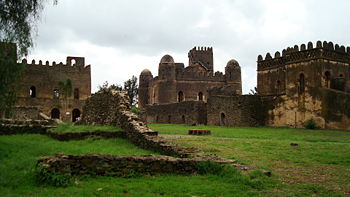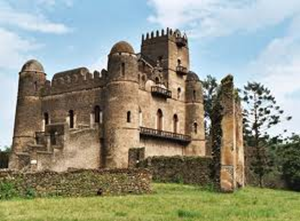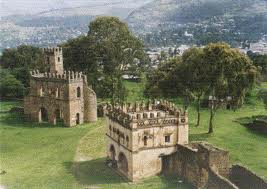
GONDAR

From kings and churches to emperors and castles: another not-to-be-missed stop on Ethiopia's Historic Route is what has been called the 'Camelot' of Africa: Gondar.
Gondar is a Royal and ancient historical city of Ethiopia. It is the home of many Emperors and Princess who lead the country from the 12th century to the last decade of the 20th century. To mention just a few, Emperor Suseneos, Emperor Fasiledes, Empress Mentwab, Iyasu I, Tewodros II, Empress Taitu. It is the home of the highest mountain in Ethiopia, Ras Dashen, and the Simien Mountains National Park.
It is easy to imagine the intrigue and pageantry that took place back in the seventeenth and eighteenth centuries, when Gondar, then the Ethiopian capital, was home to a number of emperors and warlords, courtiers and kings. One only has to stroll through the banqueting halls and gaze down from the balconies of the many castles and palaces here to drift back into a long-ago world of battles and court conspiracies.
 Nestled in the foothills of the Simien Mountains in north¬western Ethiopia, Gondar became the capital during the reign of Emperor Fasilidas (1632-1667), who built the first of a number of castle-like palaces to be found here. He established a tradition that was followed by most of his successors, whose buildings greatly enhanced the city's grandeur.
Nestled in the foothills of the Simien Mountains in north¬western Ethiopia, Gondar became the capital during the reign of Emperor Fasilidas (1632-1667), who built the first of a number of castle-like palaces to be found here. He established a tradition that was followed by most of his successors, whose buildings greatly enhanced the city's grandeur.
Gondar, which rose to prominence after Ethiopia went through a long period without a fixed capital, emerged in the seventeenth century as the country's largest settlement. In its day, the city was an important administrative, commercial, religious, and cultural centre. It was famous for its sophisticated aristocratic life, its church scholarship, and its extensive trade, which took its merchants to Sudan and the port of Massawa as well as to the rich lands south of the Blue Nile. Gondar was also noted for the skill of its many craftsmen.
The city retained its pre-eminence until the middle of the nineteenth century, when Emperor Tewodros II moved his seat of Government to Debre Tabor and later to Mekdela. As a result, Gondar declined greatly in importance and was subsequently looted in the 1880s by the Sudanese Dervishes. By the early nineteenth century the city was a mere shadow of its former self. More recently, its appearance was not aided by the fact that several historic buildings were damaged by British bombs during Ethio¬pia's liberation campaign of 1941. Most of Gondar's famous castles and other imperial buildings nevertheless survived the ravages of time: and together constitute one of Ethiopia's most fascinating antiquities.
Gondar - Ethiopian History
Gondar Documentary Video
Gondar Castle

Gondar Castle, dubbed the Ethiopian Camelot, is not a single castle, but instead is the name given to the entire complex of castles and palaces in the area. The oldest and most impressive of Gondar's imperial structures is the two-storeyed palace of Emperor Fasilidas, built of roughly hewn brown basalt stones held together with mortar. Said to have been the work of an Indian architect, the building-has a flat roof, a rectangular tower in the south-west corner — which affords a distant view of Lake Tana — four smaller domed I towers, and a battlemented parapet.
Other buildings in the 'imperial quarter' include the library of Fasilidas's son, Emperor Yohannes 1 (1667-1682), a cube-like two-storeyed structure with an outside staircase and a parapeted j Hat roof; a nearby chancellery with a slender square tower and another outside staircase; the saddle-shaped castle of Yohannes' son, Emperor Iyasu 1 (1682-1706), with a small conical tower and spiralled outer staircase; the large hall, or 'house of song' of Kmperor Dawit 11 (1716-1721), in which many ceremonies once took place, the long V-shaped reception and banqueting hall of Emperor Bakaffa (1722-1730); and the great two-storeyed pal¬ace, charmingly decorated with Ethiopian crosses in mauve-coloured tuff, of the latter’s redoubtable consort Empress Mentewab. The palace compound is also the site of the grave oi one the most remarkable nineteenth-century foreign travellers to Ethiopia: Emperor Tewodros's close friend Walter Plowden, a sometime British consul.
In addition to the fine structures in the imperial compound, visitors should see the palace of Ras Mika'el Sehul and the house of the Echege. The former, a small structure modelled on the Fasilidas castle, owes its name to its most important occupant, who became Gondar's dictator during the monarchy's decline in the eigh teen th century. The latter building is a round structure once inhabited by the Echege, the second most important official of the Ethiopian church. This little-known building is located in one of the humbler parts of the town and is known to many only by its urban registration number: House No. 1, Kebele 11. It can be reached by a short but interesting walk through town.
Several notable Gondarine structures are to be seen outside town. The most impressive, located in the Kaha River valley south of Gondar, is a well-preserved 'bathing palace' variously attributed to Fasilidas or Iyasu I. It stands in a rectangular, neatly walled depression, which is filled with water once a year for the Timkoi, or Epiphany, celebrations, and, though popularly referred to as a 'bathing palace', was probably constructed for such celebrations.
Rulers of this era also developed the area in the hills north-west of the town – called Kweskwam after the home of the Virgin Mary – as a kind of ‘Capitol Hill’ for government buildings. Most are now ruins, including the largest – a square, three-storyed castle with a flat parapet roof parapet roof and battlemented walls, embellished with a series of base-reliefs of various Ethiopian animals. Visitors to the church here can, on request, see many fine old Gondarinc manu¬scripts, and enter a crypt containing the skeletal remains of the famous eighteenth-century Empress Mentewab, her son Emperor lyasu II, and grandson Emperor Iyo'as.
Gondar was the site of numerous fine churches, a number of which have survived to this day. Perhaps the finest of the Gondarine churches is that of Debre Birhan Selassie or 'Light of the Trinity', which stands on raised ground about a half an hour's walk to the north-east. An imposing rectangular structure, its ceilings are decorated with beautiful winged angels and its walls with impressive scenes depicting biblical events, including the lives of Christ, Mary, the saints and the martyrs.


